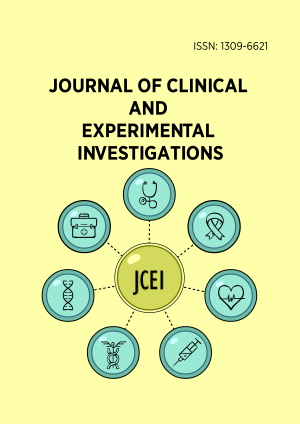Volume 1, Issue 2, September 2010
Research Article
A clinico-etiological study of cervical lymphadenopathy in children with special reference to ultrasonography
J Clin Exp Invest, Volume 1, Issue 2, September 2010, 71-74
https://doi.org/10.5799/ahinjs.01.2010.02.0015Research Article
Comparing analgesic and hemodynamic effects of unilateral spinal levobupivacaine, levobupivacaine-fentanyl and levobupivacaine-morphine combinations for arthroscopic procedures
J Clin Exp Invest, Volume 1, Issue 2, September 2010, 75-80
https://doi.org/10.5799/ahinjs.01.2010.02.0016Research Article
The seroprevalence of antibodies against Toxoplasma gondii and Rubella virus among childbearing age women in Mardin province
J Clin Exp Invest, Volume 1, Issue 2, September 2010, 81-85
https://doi.org/10.5799/ahinjs.01.2010.02.0017Research Article
The effect of intraarticular local anaesthesia on postoperative pain in arthroscopic knee surgery
J Clin Exp Invest, Volume 1, Issue 2, September 2010, 86-90
https://doi.org/10.5799/ahinjs.01.2010.02.0018Research Article
The opinions of nurses and physicians related to euthanasia
J Clin Exp Invest, Volume 1, Issue 2, September 2010, 91-98
https://doi.org/10.5799/ahinjs.01.2010.02.0019Research Article
Seroprevalences of HBV, HCV and HIV among healthcare workers in a state hospital
J Clin Exp Invest, Volume 1, Issue 2, September 2010, 99-103
https://doi.org/10.5799/ahinjs.01.2010.02.0020Research Article
The results of cervical cerclage in a single center during a five-year period
J Clin Exp Invest, Volume 1, Issue 2, September 2010, 104-107
https://doi.org/10.5799/ahinjs.01.2010.02.0021Research Article
Changes in left ventricular functions after coronary artery by-pass surgery
J Clin Exp Invest, Volume 1, Issue 2, September 2010, 108-112
https://doi.org/10.5799/ahinjs.01.2010.02.0022Research Article
Severe respiratory failure secondary to Varicella zoster pneumonia
J Clin Exp Invest, Volume 1, Issue 2, September 2010, 113-116
https://doi.org/10.5799/ahinjs.01.2010.02.0023Case Report
Nasal septal abscess
J Clin Exp Invest, Volume 1, Issue 2, September 2010, 117-118
https://doi.org/10.5799/ahinjs.01.2010.02.0024Case Report
Toxic reaction related to high dose lidocaine secondary to intravenous regional anesthesia
J Clin Exp Invest, Volume 1, Issue 2, September 2010, 119-121
https://doi.org/10.5799/ahinjs.01.2010.02.0025Case Report
Anterior chest wall musculoskeletal tuberculosis
J Clin Exp Invest, Volume 1, Issue 2, September 2010, 122-124
https://doi.org/10.5799/ahinjs.01.2010.02.0026Review
Diagnosis and treatment strategies of thrombophilic risk factors
J Clin Exp Invest, Volume 1, Issue 2, September 2010, 125-133
https://doi.org/10.5799/ahinjs.01.2010.02.0027Review
Formation and clinical importance of postoperative peritoneal adhesions
J Clin Exp Invest, Volume 1, Issue 2, September 2010, 134-137
https://doi.org/10.5799/ahinjs.01.2010.02.0028Letter to Editor
Coexistance of JAK2V617F mutation and BCR/ABL translocation in one patient
J Clin Exp Invest, Volume 1, Issue 2, September 2010, 138-140
https://doi.org/10.5799/ahinjs.01.2010.02.0029Letter to Editor
Herpes Zoster ophthalmicus with occulomotor nerve palsy
J Clin Exp Invest, Volume 1, Issue 2, September 2010, 141-142
https://doi.org/10.5799/ahinjs.01.2010.02.0030
